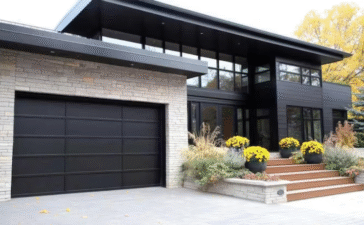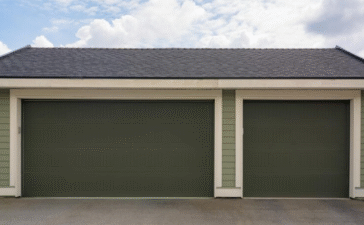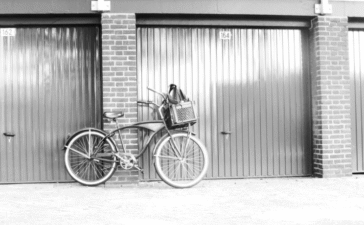Walking into your garage and being hit with a damp, musty smell is more than just unpleasant. It’s a clear warning sign of high humidity, a problem that can lead to rust on your car, mold on the walls, and even structural damage to your home. Many homeowners overlook their garage when thinking about air quality, but controlling moisture in this space is crucial for protecting your valuable assets and maintaining a healthy environment. High humidity in a garage occurs when there’s too much water vapor in the air. This excess moisture can come from various sources, like rain-soaked cars, melting snow, poor ventilation, or even cracks in the foundation. Over time, these garage humidity problems can cause condensation on garage walls, rust on tools and equipment, and the warping of wooden structures. If left unchecked, this damp environment becomes a perfect breeding ground for mold and mildew, which pose health risks and can cause significant damage. This comprehensive guide will walk you through everything you need to know about dehumidifying a garage. We’ll cover why it’s so important, the common causes of moisture in a garage, and step-by-step solutions to fix the problem for good. By the end, you’ll have a clear action plan to transform your damp garage into a dry, protected space.
Why Dehumidifying a Garage Matters
Controlling humidity in your garage is not just about comfort; it’s about protecting your investments and your home’s structural integrity. A dry garage safeguards everything from your vehicle to the very foundation of the building.
Protecting Your Vehicle
Your car is one of your most significant investments, and high humidity can cause serious harm. Constant exposure to damp air accelerates the rusting process on the vehicle’s metal body, undercarriage, and brake components. This humidity damage in the garage can lead to costly repairs and decrease your car’s lifespan and resale value. Furthermore, moisture can infiltrate the sensitive electronics, potentially causing malfunctions in the infotainment system, wiring, and engine control unit. The interior isn’t safe either, as dampness can lead to musty odors and mold growth on upholstery and carpets.
Protecting Tools, Equipment, and Storage Items
Many people use their garage to store valuable tools, sporting equipment, and other personal belongings. High humidity is the enemy of these items. Metal tools and machinery are highly susceptible to rust, which can render them unusable. Wooden furniture or stored items can warp, swell, or rot. Even items stored in cardboard boxes can be ruined, as the boxes absorb moisture, weaken, and become a food source for mold. Effective rust prevention in a garage starts with controlling the air’s moisture content.
Preventing Mold and Mildew
Perhaps the most serious risk of a damp garage is the growth of mold and mildew. These fungi thrive in humid environments and can grow on drywall, wood studs, concrete, and stored items. Mold in the garage isn’t just an eyesore; it releases spores into the air that can trigger allergies, asthma attacks, and other respiratory problems. According to the CDC, exposure to mold can cause symptoms like a stuffy nose, wheezing, and red or itchy eyes. Over time, mold can also cause significant garage moisture damage by eating away at organic materials like wood and paper-faced drywall.
Maintaining Structural Integrity
Persistent moisture can compromise the structural integrity of your garage. Water vapor can seep into porous materials like concrete and wood, weakening them over time. Damp walls and foundations can lead to cracking, spalling (flaking), and a general degradation of the structure. In severe cases, this can affect the stability of the entire garage and even parts of the attached home.
Common Causes of High Humidity in Garages
Understanding the root causes of garage dampness is the first step toward finding a lasting solution. High humidity is rarely due to a single issue but rather a combination of factors.
One of the most frequent causes of a humid garage is poor ventilation. Garages are often built with limited airflow, which traps moist air inside. Without a way for damp air to escape and fresh air to enter, humidity levels inevitably rise.
Water entering the garage is another major contributor. This can happen when the weatherstripping on the garage door is worn or damaged, allowing rain to seep in under the door. Cracks in the foundation or walls can also provide an entry point for groundwater, especially after heavy rain.
Condensation from temperature differences is also a common problem. When warm, moist air comes into contact with a cold surface, like a concrete floor or uninsulated walls, the water vapor condenses into liquid droplets. This is particularly noticeable in climates with significant temperature swings.
Our daily habits can introduce moisture as well. Parking wet cars or bringing in snow-covered equipment adds a surprising amount of water to the air as it evaporates. If you have a plumbing line running through your garage, even a small, undetected leak can be a constant source of humidity. Finally, uninsulated garage walls and ceilings do little to buffer against outside temperatures, exacerbating condensation issues and making it harder to control the indoor climate.
What Is the Ideal Humidity Level for a Garage?
To effectively combat moisture, you need a target. The ideal humidity for a garage is generally between 40% and 60% relative humidity (RH). This range is dry enough to prevent the most common garage humidity problems like mold growth, rust, and wood rot, while not being so dry that it could damage sensitive materials.
It’s particularly important that the garage RH level does not exceed 60%. Above this threshold, the risk of mold and mildew growth increases exponentially. Many types of mold can begin to flourish at just 60% RH. High humidity also accelerates corrosion and can make the air feel sticky and uncomfortable.
To monitor garage humidity accurately, you’ll need a hygrometer. This is a small, inexpensive device that measures the amount of moisture in the air. Placing a digital hygrometer in your garage will give you real-time readings, allowing you to see if your efforts to control humidity are working and to know when you need to take action.
How to dehumidifying a garage: A Step-by-Step Guide
Reducing garage humidity is a process that involves several steps, from identifying the source of the moisture to implementing a combination of solutions.
Step 1: Identify the Moisture Source
Before you can fix the problem, you need to know where the water is coming from. Conduct a thorough visual inspection of your garage. Look for obvious signs like water pooling on the floor, damp spots on the walls, or condensation on windows and pipes. Check for plumbing leaks from any pipes running through the garage and inspect the foundation for signs of seepage after a storm.
Step 2: Seal Gaps and Cracks
Your next step is to stop more water from getting in. Inspect the weatherstripping around your garage door and replace it if it’s cracked, brittle, or flattened. Use a high-quality sealant to fill any cracks you find in the concrete floor, wall joints, or around windows. This simple step is one of the best ways to reduce garage humidity originating from external sources.
Step 3: Improve Ventilation
Improving airflow is critical to prevent condensation in the garage. You can install passive vents in the walls or roof to allow moist air to escape. For more active control, consider installing an exhaust fan on an exterior wall, which will actively pull damp air out. If your garage has windows on opposite walls, opening them to create cross-ventilation on dry days is a free and effective strategy.
Step 4: Increase Insulation
Insulating your garage helps to stabilize the temperature of interior surfaces, reducing condensation. An insulated garage door can make a huge difference, as can adding insulation to the walls and ceiling. This creates a thermal barrier that keeps surfaces warmer, preventing moist air from condensing on them.
Step 5: Use a Garage-Rated Dehumidifier
For persistent humidity problems, a dehumidifier is your most powerful tool. The garage dehumidifier setup is crucial for success. You’ll need to choose between a desiccant or refrigerant unit based on your climate. Then, select the correct capacity, measured in pints of water removed per day, based on your garage’s square footage and dampness level.
Step 6: Add Air Circulation
Keeping the air moving helps prevent moisture from settling on surfaces. A simple box fan or a strategically placed ceiling fan can significantly improve air circulation, helping the dehumidifier work more efficiently and distributing dry air throughout the space.
Step 7: Use Moisture Absorbers (Optional)
For smaller, enclosed spaces within the garage or as a supplement to a dehumidifier, you can use moisture absorbers. Products containing calcium chloride or silica gel can be placed in closets, cabinets, or near damp spots to pull moisture from the air. These are not a primary solution for a large garage but can be helpful in targeted areas.
Choosing the Right Dehumidifier for dehumidifying a garage
Selecting the best dehumidifier for a garage depends on its size, your climate, and your desired level of convenience.
Capacity Requirements
Dehumidifier capacity is measured by how many pints of moisture it can remove from the air in 24 hours. A moderately damp garage of up to 1,500 square feet, a 30-pint unit may suffice. For garages up to 2,500 square feet or those that are very damp, a 50-pint model is a better choice. For large or extremely wet garages, a 70-pint or even a commercial-grade unit might be necessary. It’s generally better to choose a slightly larger capacity than you think you need to ensure it can handle peak humidity levels.
Climate Considerations
The climate where you live is a major factor. Refrigerant dehumidifiers work by cooling metal coils to condense water from the air. These are highly effective in warm, humid climates but lose efficiency and can freeze up in temperatures below 65°F (18°C). For unheated garages in colder climates, a desiccant dehumidifier is the better option. These units use a moisture-absorbing material and a small heater, allowing them to operate effectively even in near-freezing temperatures.
Drainage Options
A dehumidifier’s collection bucket will fill up quickly in a damp garage, requiring you to empty it frequently. For a more hands-off approach, choose a model with a continuous drain option. This allows you to connect a hose that directs the collected water to a floor drain or outside. Some advanced models even feature a built-in pump to push water upward and out a window or into a utility sink, offering maximum flexibility in dehumidifier placement in the garage.
Placement Guidelines
Where you put the dehumidifier matters. For optimal performance, place it in the center of the garage, if possible, with at least 12 inches of clearance on all sides to ensure unrestricted airflow. Avoid placing it in a corner or against a wall, as this will block the air intake and reduce its effectiveness.
Is a Dehumidifier Enough?
While a dehumidifier is a powerful tool, it may not be a complete solution if you have underlying structural moisture problems in your garage. If you notice water seeping through the foundation after rain or have a persistent roof leak, these structural issues must be repaired first. A dehumidifier can’t remove water faster than a significant leak lets it in.
Similarly, a poorly sealed garage door can let in so much moist air that the dehumidifier is forced to run constantly without ever reaching the target humidity level. In cold climates, running a refrigerant dehumidifier in an unheated garage is often ineffective, as the unit will spend more time in defrost mode than actually removing moisture. In these scenarios, the most effective approach is to combine solutions: seal all air leaks, add insulation, improve ventilation, and then use the right type of dehumidifier for your climate.
Additional Moisture Control Strategies
Beyond the main steps, several other garage waterproofing and moisture control methods can enhance your efforts. Installing a vapor barrier on the walls before adding drywall can prevent moisture from the outside from seeping through. Applying an epoxy coating or a concrete sealer to the floor creates an impermeable surface that stops moisture from rising through the slab.
You can also make a habit of drying off wet vehicles and equipment before parking them in the garage. Finally, if your garage is heated, maintaining a stable indoor temperature can help prevent condensation by keeping surface temperatures above the dew point. These strategies work together to stop garage moisture at its source.
How to Know Your Garage Is Too Humid
Your senses are often the first to alert you to signs of humidity in the garage. A persistent musty or earthy smell is a telltale indicator of mold or mildew. Visible signs include condensation beading on walls, windows, or pipes, and small puddles of water on the floor. If you see dark spots or fuzzy growth on drywall or stored items, you have active garage mold signs.
Another clue is the condition of your stored items. Check your metal tools for signs of rust and corrosion. Look at wooden items or cardboard boxes for signs of warping, swelling, or water stains. If you notice any of these garage rust issues or moisture damage, it’s a clear signal that your garage’s humidity is too high.
Also read: “garage journal“
Take Back Your Garage From Humidity
Effectively dehumidifying your garage requires a multi-faceted approach. By combining strategies sealing air leaks, improving ventilation, adding insulation, and using the right dehumidifier for your space you can win the battle against moisture. Long-term moisture control protects your valuable investments, prevents unhealthy mold growth, and preserves the structural integrity of your home. Also dry, stable environment makes your garage a more useful and pleasant space for projects, storage, and everything in between.
Frequently Asked Questions
Do dehumidifiers work in cold garages?
Yes, but the type of dehumidifier matters. Standard refrigerant dehumidifiers are not effective in temperatures below 65°F (18°C) and can freeze up. For an unheated or cold garage, a desiccant dehumidifier is the best choice, as it is designed to operate efficiently in low temperatures.
Can I run a dehumidifier in a detached garage?
Absolutely. A dehumidifier can be run in a detached garage, provided you have a power source. It’s especially important to choose the right type for the climate, as a detached garage will likely experience more extreme temperature fluctuations than an attached one. A desiccant model is often the safest bet for detached garages in most climates.
Should I run a dehumidifier all year?
This depends on your climate and your garage’s condition. In consistently humid regions, you may need to run it year-round. In other areas, you might only need it during the humid summer months or the damp spring and fall. Using a hygrometer to monitor the RH level is the best way to determine when the dehumidifier needs to run. Many modern units have a built-in humidistat that will automatically turn the machine on and off to maintain your desired humidity level.
How many hours a day should a dehumidifier run?
Ideally, a dehumidifier should run as long as it takes to reach and maintain your target humidity level (typically 40-50% RH). When you first set it up in a very damp garage, it may run continuously for several days. Also once the target level is reached, a unit with an automatic humidistat will cycle on and off as needed, which might only be a few hours per day.
Can garage humidity damage my car?
Yes, high humidity can cause significant damage to your car. It promotes rust and corrosion on the body, frame, and brake components. Moisture can also damage sensitive electronics and lead to mold and mildew growth in the car’s interior, creating foul odors and potential health concerns. Controlling garage humidity is a key part of protecting your vehicle.












